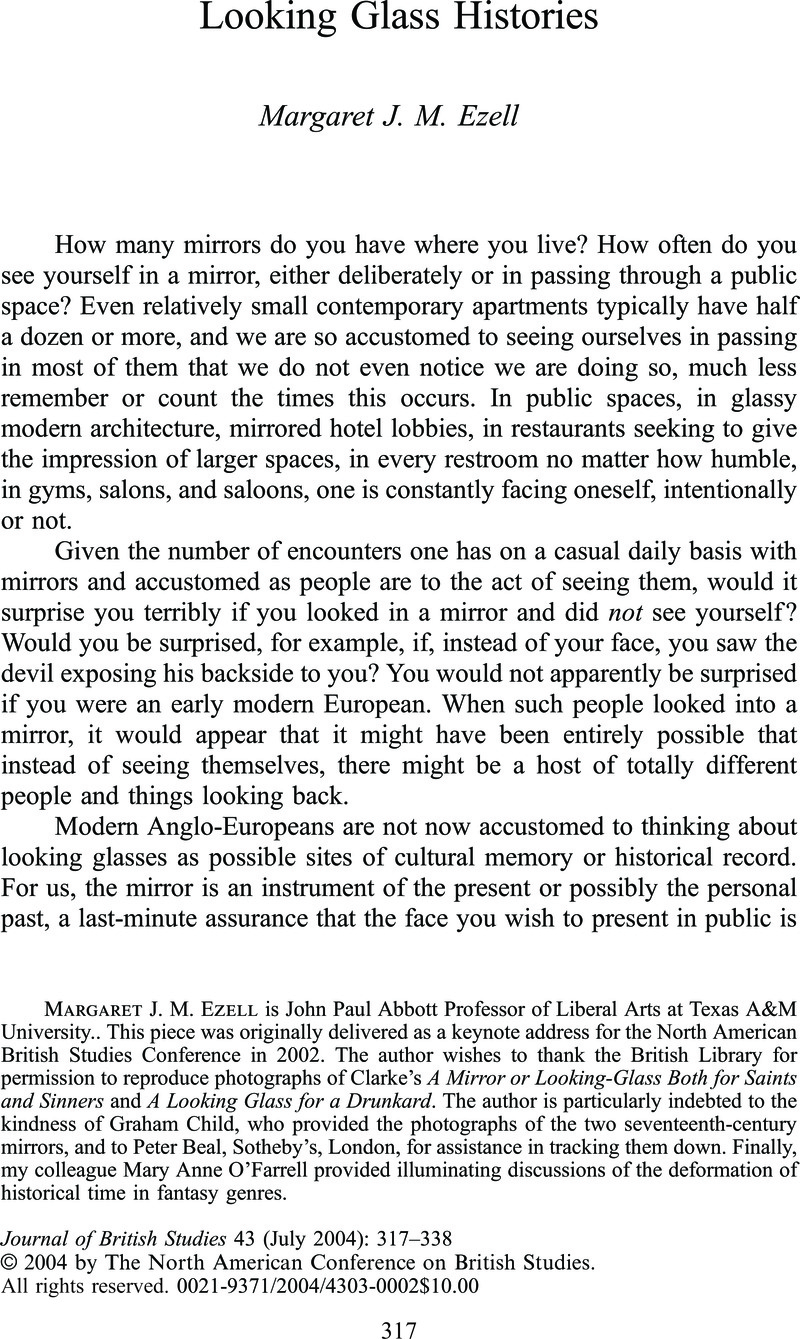Article contents
Looking Glass Histories
Published online by Cambridge University Press: 21 December 2012
Abstract

- Type
- Research Article
- Information
- Copyright
- Copyright © North American Conference of British Studies 2004
References
1 Norbrook, David, “The English Revolution and English Historiography,” in The Cambridge Companion to Writing of the English Revolution, ed. Keeble, N. H. (Cambridge, 2001), p. 235Google Scholar.
2 In the process of converting this piece from a talk to an article, I came across Shevlin, Eleanor F.'s article “To Reconcile Book and Title, and Make ‘em Kin to One Another: The Evolution of the Title's Contractual Functions,” Book History 2, no. 1 (1999): 42–77CrossRefGoogle Scholar, which also discusses the iconography of this particular edition's title page. However, Shevlin continues Grabes's interpretation of it as a manifestation of the medieval, renaissance trope of the speculum and attaches no significance to the particular historical moment in which this text was designed.
3 Clarke, Samuel, A Mirror or Looking-Glass Both for Saints & Sinners, Held forth in some Thousands of Examples…, 4th ed. (London, 1671)Google Scholar.
4 Grabes, Herbert, The Mutable Glass: Mirror-Imagery in Titles and Texts of the Middle Ages and English Renaissance, trans. Collier, Gordon (Cambridge, 1982), p. 292Google Scholar. Another useful study of earlier literary texts is Nolan, Edward Peter, Now through a Glass Darkly: Specular Images of Being and Knowing from Virgil to Chaucer (Ann Arbor, Mich., 1990)Google Scholar; several general studies have also been done on the presence of mirrors as symbolic objects in art: Werness, Hope, The Symbolism of Mirrors in Art from Ancient Times to the Present (Lewiston, Pa., 1999)Google Scholar.
5 Grabes, The Mutable Glass, pp. 33–34.
6 See, e.g., discussions in Shevlin, “To Reconcile Book and Title”; Hunter, J. Paul, Before Novels: The Cultural Contexts of Eighteenth Century English Fiction (New York, 1990)Google Scholar; and Ezell, Margaret J. M., Social Authorship and the Advent of Print (Baltimore, 1999)Google Scholar.
7 Milton, John, Paradise Lost in The Riverside Milton, ed. Flannagan, Roy (New York, 1998), p. 456 (bk. 4, pp. 465–68)Google Scholar.
8 For general accounts of the history of mirror manufacture, see Child, Graham, World Mirrors, 1650–1900 (London, 1990)Google Scholar; and Goldberg, Benjamin, The Mirror and Man (Charlottesville, Va., 1985)Google Scholar.
9 Melchior-Bonnet, Sabine, The Mirror: A History, trans. Jewett, Katherine H. (London, 2001), pp. 46–47Google Scholar.
10 Child, World Mirrors, p. 59.
11 See ibid; and Melchior-Bonnet, The Mirror, p. 66.
12 Goldberg, The Mirror and Man, pp. 169, 172.
13 For the Church's response to superstitions concerning mirrors, see Melchior-Bonnet, The Mirror, pp. 191–92.
14 MacFarlane, Alan, Witchcraft in Tudor and Stuart England: A Regional and Comparative Study (New York, 1970), p. 125CrossRefGoogle Scholar.
15 Melchior-Bonnet, The Mirror, p. 103.
16 Hutchinson, Lucy's, Translation of Lucretius: De rerum natura, ed. de Quehen, Hugh (Ann Arbor, Mich., 1996), p. 121Google Scholar.
17 Extensive folklore concerning mirrors, witches, and the spirits of the dead can be found in many cultures, including African, European, Hispanic, and Asian. For general references, see Opie, Iona and Tatem, Moira, eds., Dictionary of Superstitions (Oxford, 1989)Google Scholar; Daniels, Cora Linn and Stevens, C. M., eds., Encyclopedia of Superstitions, Folklore, and the Occult Sciences of the World (1903), 3 vols. (Detroit, 1971)Google Scholar; Grant, James, The Mysteries of All Nations (Detroit, 1971)Google Scholar; Ashe, Geoffrey, Mythology of the British Isles (London, 1991)Google Scholar.
18 Melchior-Bonnet, The Mirror, p. 115.
19 See Spufford, Margaret, Small Books and Pleasant Histories: Popular Fiction and Its Readership in Seventeenth-Century England (Athens, Ga., 1981)Google Scholar; Pollard, Michael, Ballads and Broadsides (New York, 1969)Google Scholar; Preston, Cathy Lynn and Preston, Michael J., eds., The Other Print Tradition: Essays on Chapbooks, Broadsides and Related Ephemera (New York, 1995)Google Scholar.
20 A Looking-Glass for a Bad Husband: Or, a Caveat for a Spend-thrift (London, 1670)Google Scholar.
21 Fancies Favourite, or The Mirror of the Times (London, 1670?)Google Scholar.
22 A Looking Glass for a Drunkard (London, 1670)Google Scholar.
23 Hunter, Before Novels, pp. 285, 314–15.
24 Clarke, Samuel, The Lives of Sundry Eminent Persons in this Later Age (London, 1683)Google Scholar.
25 Ibid., p. A3r.
26 Ibid.
27 Ibid., p. 57.
28 Ibid., p. 67.
29 Ibid., p. 93.
- 6
- Cited by


